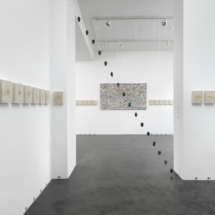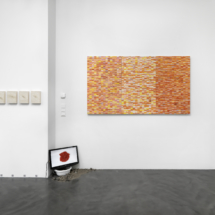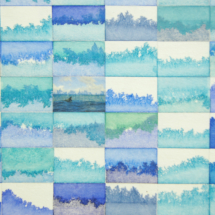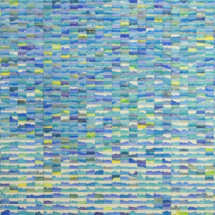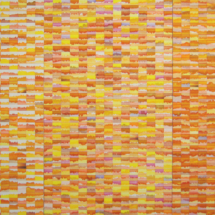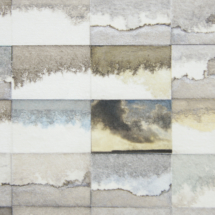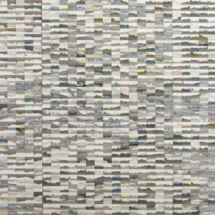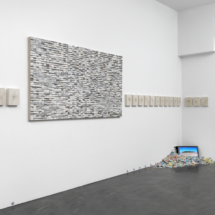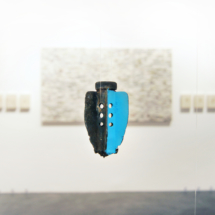Misfits, Offcuts and Castaways
Yi Dai
Exhibition: 30 April – 16 July
House of Egorn is pleased to present the first solo exhibition by Yi Dai in the gallery. Opening in conjunction with Berlin Gallery Weekend, she presents three new bodies of work. All of them reflect back to one year that she spent on the Marshall Islands in 2010/2011. Since that time, the Marshall Islands has appeared increasingly frequently in the news as the islands are gradually washed away by rising sea levels and islanders continue to face the threats of radiation still present decades after the nuclear testing done on the area by the United States military. As Yi Dai recalls that year on the island in a retrospective sense, an imminent sense of future crises appears foreboding throughout her project.
Yi Dai describes her working methods as the shrinking down of large-scale forces into miniature works on a human scale. Using fire, ice, and time, she uses the elements that now threaten the islands in order to commemorate them and raise awareness of their specific troubles. Incense becomes a metaphor for nuclear explosions, ice cubes for Greenlandic glaciers, and water and ink that reach into small pieces of Japanese paper become the vast ocean that creeps ever closer inland.
The exhibition is a very personal story of Dai’s own experiences but also questions the way that art can involve activism. Dai believes that art is a powerful tool for awareness but her own process relies on subjective experiences and raw data. Rather than making aggressive claims to action, she displays information in order to incite thought and discussion. Berlin acts as the perfect context for an exhibition that speaks of the threats now facing an entire population. With Germany having an important role in the recent refugee crisis, the exhibition warns of the next wave of displaced people, the first environmental refugees.
The exhibition is accompanied by a text by Fatoş Űstek who was most recently involved in Fig. 2 at the Institute of Contemporary Art, London. This project similarly focused on temporal crises in contemporary culture. Events are often the only focus of viewers, but it is more difficult to see a string of events that lead to gradual culminations of one larger narrative.
Force Fields
In recent times, the word Anthropocene is referenced frequently; marking a new epoch, a new era of transition through humanity’s significant global impact on the world’s ecosys- tems. Yi Dai’s ‘Misfits, Offcuts and Castaways’ concentrates on one specific endangered piece of land: the Marshall Islands in the Pacific Ocean. Dai revisits its antediluvian volcanic formations, its recent history of being exploited as a nuclear bombing site and its current state of affairs as an archipelago that is threatened by rising sea levels. Dai expands into the present and future consequences of foreboding environmental crisis, contemplating beyond the predictable outcomes of climate and geological change. The result, manifested as an exhibition of many folds, takes us on a journey exploring the dichotomy between reality and fiction, between natural processes and human activity.
In ‘Misfits, Offcuts and Castaways’, different strands of conceptual experiments and elab- oration on the notion of force are at play. Dai constructs the exhibition through codes and allegories, introducing an intricate, yet playful approach. The setup recreates the scenario of being on an Atoll - a ring-shaped coral reef, island, or series of islets. The display of works take a phenomenological role on the visualisation of the seascape of an atoll, while the works are evocative of its materialities, movements and sounds. The exhibition is choreographed in regard to the geographical formation of those islands, with the sea surrounding each island from the outside and with lagoons occupying the inside. Moreover, the exhibition not only addresses the forces exerted by nuclear experiments, but also the active forces of matter and energy. The intricate components of the exhibition crystallize into a force field, confronting, critiquing, and transforming the damaged life of the Marshall Islands. We can classify these multifarious strands of forces in Dai’s works into five categories: residue of forces, forces of equanimity, force of induction, force of contemplation, force of transformation.
The ‘residue of forces’ denotes the set of altered realities, as in the changes in the environ- mental ecology of an island after the explosion of a hydrogen bomb. Dai sets out to seek the main denominators in the Marshall Islands that are causing the environmental change, tracing the impact of past events in the profile of the current situation. Hence, the nuclear testing and bombings that took place on those islands and their residual affect comes to play a central role in the exhibition. At times, Dai chooses to direct her immediate attention to physical objects such as mortars, investigating the large events these objects must have once been part of. Observing the tanks decaying on the beaches since their use during World War II, she concentrates on remainders that linger invisible to the human eye but nevertheless directly affect people, objects, and nature.
Allowing things to happen in a continuous process of gradual change, Dai attunes herself to the ‘force of equanimity’: the fact that the matter and energy affect one another in various ways, attuned to arrive at an equilibrium, a balance point. Dai stages a laborious experiment, driven by her interest in the nature of things, their residual change and the original context of those forms. The series Tide Tables (2016) is the outcome of an arduous production where hundreds of same-size paper clippings are dipped in ink for an identical duration of one second, allowing the ink to carve its own path into the paper. Following a personal scientific methodology, she places paper and ink in relation to the same point of contact, which are then grouped by their monochrome colours: orange-magenta, blue-turquoise and silver-grey, joined by small-scale print outs of the photographs of the islands.
If we were to define the ‘force of induction’ as one entity inserting force on another through the activation of its potential, we would observe the resulting encounter as a change in the latter. Fire can be classified as a force of induction, where it alters materials to varying de- grees. In Catalogue of Light (2016), Dai employs the force of fire as an allegory and a tool. She alludes to ancestral and ritual uses of fire by using incense sticks to produce ‘drawings’ with which she burns margins of thin pieces of paper. The traces of the incense burned on the paper emerge as reminiscent of contour graphs. The multiple sizes of paper, are then stacked together in a frame, the layers of which demarcate the topographic representation of the islands where the points of equal height at a given level are connected. Catalogue of Light, emerges as a grouping of topographical maps, most significantly an allegorical depiction of the island cluster that was exploited during twelve years of nuclear testing.
In an alliance with the ‘force of contemplation’, Dai meditates on loss and the destruction of the Marshall Islands. She visits national archives on nuclear testing, contemplates the photographs she has taken during her stay, tunes in with Google Earth for an aerial grasp of the bigger picture. She ponders upon the abstracted state of the islands from above, marking their geographical profiles in drawing, pasted on reflective surfaces. Miniature Catastrophe (2016) is a composite grid formed of the aforementioned drawings, that displays the archi- pelago from an aerial view, pronouncing the marks and traces of destruction resulting from human activity and melting Greenlandic ice that while worlds away from the atolls, directly threatens their survival.
In an altered manner, Dai documents her processes of production, juxtaposing with the found footage of the atrocious destruction caused by nuclear tests. The three-channel video installation Misfits, Offcuts and Castaways No.1, No.2, No.3 (2016) is the result of Dai’s meth- odological processes and the ways in which she constructs, composes, and conceptualises her works. Employing a transitional editing method, Dai collides and combines images from two different frames of reference that build on destructive reality.
If ‘force of transformation’, were to refer to the energy that has been put in place in order to arrive at an understanding, ‘Misfits, Offcuts and Castaways’, encapsulates modalities of transformation, transition and change for the same purpose. In the case of this exhibition it is evocative of the artistic intent, the inherent methods of artistic production, and the aware- ness raised through the encounter with these artworks.
text by Fatoş Űstek
(independent curator and writer based in London. She is Art Fund curator at fig-2, and formerly acted as associate curator for the 10th Gwangju Biennale; she writes regularly for magazines and publications)
